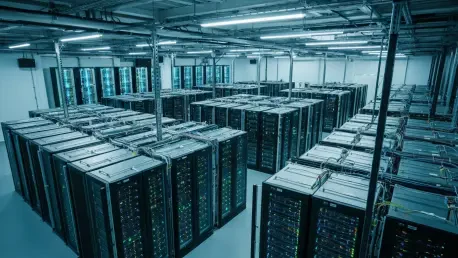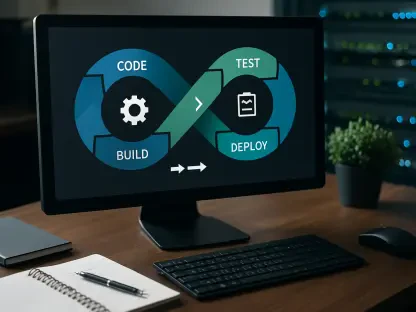In an era where digital transformation dictates the pace of global economies, data centers stand as the backbone of technological progress, processing an estimated 2.5 quintillion bytes of data daily to fuel artificial intelligence, cloud computing, and big data analytics. This staggering volume underscores a pressing challenge: how to manage such vast infrastructure efficiently while balancing energy demands and security risks. Amid this dynamic landscape, a significant development has emerged from Hong Kong, where StarFive Technology has introduced a groundbreaking solution poised to redefine data center management. This report delves into the unveiling of this innovation, exploring its implications for an industry at the crossroads of scalability and sustainability, and examining the broader trends shaping the future of computing infrastructure.
The Data Center Industry: Current Landscape and Significance
The data center industry is a cornerstone of modern technology, enabling the seamless operation of cloud services, AI algorithms, and vast data storage systems that power businesses and governments worldwide. With global internet traffic projected to grow at a compound annual rate of 26% through 2027, the demand for robust data center capacity continues to soar. This growth is driven by the proliferation of connected devices and the increasing reliance on real-time data processing, positioning data centers as critical economic assets with an estimated market value exceeding $300 billion globally.
Key segments within this sector include infrastructure management, energy efficiency, and cybersecurity, each addressing distinct operational challenges. Infrastructure management focuses on optimizing hardware and software integration, while energy efficiency tackles the staggering power consumption that accounts for nearly 2% of global electricity usage. Cybersecurity, meanwhile, remains paramount as data breaches cost companies billions annually, necessitating advanced protective measures. These areas collectively highlight the multifaceted nature of data center operations, where innovation is not a luxury but a necessity.
Technological architectures such as RISC-V, x86, and ARM play pivotal roles in shaping industry standards, with major players like Intel, AMD, and NVIDIA dominating the market through proprietary solutions. However, the rise of open-source frameworks like RISC-V signals a shift toward greater flexibility and cost-effectiveness, challenging traditional dominance. As global demand escalates, particularly in regions like Asia-Pacific, the economic significance of data centers becomes even more pronounced, driving job creation, infrastructure investment, and regional technological leadership.
StarFive’s Lion Rock Chip: A Technological Breakthrough
Unveiling the Innovation: Features and Capabilities
On November 14, 2025, StarFive Technology made headlines in Hong Kong by launching the Lion Rock Chip, a cutting-edge data center management chip built on the RISC-V architecture. This marks a historic step as one of the first large-scale commercial applications of RISC-V in this domain, traditionally led by other architectures. Designed to act as a central hub for operational oversight, the chip addresses critical functions such as system security, energy scheduling, and AI-driven management, meeting the urgent needs of modern data centers.
At its core, the Lion Rock Chip boasts a high-performance RISC-V processor developed in-house by StarFive, complemented by a coherent on-chip network for seamless data flow. Its integrated security modules provide robust defense against cyber threats, while a dedicated AI engine enables intelligent automation of maintenance tasks. These features collectively ensure not only operational stability but also significant energy savings, aligning with industry priorities for sustainable solutions.
What sets this chip apart is its adaptability, allowing customization to meet specific application demands through the open nature of RISC-V. Peripheral interfaces further enhance its versatility, supporting diverse communication protocols within data center environments. By prioritizing scalability and efficiency, StarFive has positioned this innovation as a direct response to the sector’s evolving challenges, promising to streamline operations for enterprises navigating digital expansion.
Market Impact and Growth Potential
The data center management chip market is on a steep upward trajectory, with current annual shipments standing at approximately 16 million units and projections estimating a rise to 30-40 million by 2030. This growth reflects the escalating need for advanced management solutions as data centers expand to support AI workloads and edge computing. StarFive’s entry into this space with the Lion Rock Chip introduces a competitive alternative that combines high performance with energy efficiency, potentially reshaping market dynamics.
Target applications for this chip span critical areas such as AI servers, edge computing platforms, and smart energy systems, each representing high-growth segments within the broader industry. Its ability to adapt to varied use cases through RISC-V’s open architecture offers a distinct edge over proprietary counterparts, appealing to cost-conscious and innovation-driven enterprises. Analysts anticipate that such versatility could carve out a substantial market share for StarFive, especially in regions prioritizing technological independence.
Looking ahead, the chip’s influence may extend beyond immediate applications, driving trends toward modular and open-source solutions in data center design. As companies grapple with balancing performance and operational costs, this innovation could catalyze a broader shift in how infrastructure is managed, positioning StarFive as a key player in shaping the industry’s future trajectory. The potential for widespread adoption underscores a transformative opportunity within a rapidly evolving market.
Challenges in Data Center Innovation
The data center industry faces formidable hurdles, with rising energy costs topping the list as facilities consume vast amounts of power, often straining national grids. Environmental concerns compound this issue, as carbon emissions from these operations draw scrutiny from regulators and activists alike, pushing for greener practices. Simultaneously, cybersecurity risks loom large, with sophisticated attacks targeting sensitive data, necessitating constant vigilance and investment in protective technologies.
Adopting open-source architectures like RISC-V presents its own set of challenges, particularly in a market long dominated by proprietary systems. Resistance from established players, coupled with compatibility concerns, can slow integration into existing frameworks, requiring significant effort to build trust and demonstrate reliability. Additionally, the lack of a mature ecosystem for RISC-V compared to x86 or ARM architectures poses technical barriers, demanding robust developer support and standardized tools to gain traction.
Addressing these obstacles requires a multifaceted approach, including collaborative ecosystems where industry stakeholders share expertise and resources. Government incentives for sustainable technology adoption, alongside advancements in green computing, offer potential pathways forward. StarFive tackles these issues head-on with the Lion Rock Chip’s energy-efficient design and strategic partnerships with entities like Inspur HyperCloud and Intel China, ensuring compatibility and fostering industry-wide acceptance through joint innovation efforts.
Regulatory and Compliance Landscape
Data centers operate within a complex regulatory framework, with energy efficiency standards becoming increasingly stringent as governments aim to curb environmental impact. Policies such as the European Union’s Energy Efficiency Directive mandate reductions in power usage, directly influencing facility design and operation. Concurrently, data security laws like the General Data Protection Regulation impose strict requirements on safeguarding information, compelling companies to integrate compliant solutions into their infrastructure.
Compliance with international benchmarks is critical for chip manufacturers, as non-adherence can limit market access and damage reputations. Functionality and design must align with global standards to ensure interoperability and legal adherence, a factor StarFive has prioritized in the Lion Rock Chip’s development. Meeting these criteria not only enhances the product’s credibility but also facilitates its adoption across diverse regulatory environments, a key consideration for global deployment.
Regional policies, particularly in Hong Kong, play a supportive role in fostering tech innovation through favorable investment climates and infrastructure incentives. This nurturing environment has been instrumental in StarFive’s ability to bring cutting-edge solutions to market swiftly. The broader impact of such regulations shapes the acceptance of new architectures like RISC-V, as supportive frameworks can accelerate integration into mainstream applications, influencing global competitiveness and technological progress.
Future Directions for Data Centers and RISC-V Technology
Emerging trends in the data center sector point toward greater adoption of open-source architectures, with RISC-V gaining momentum as a viable alternative to traditional systems. This shift is fueled by a desire for cost-effective, customizable solutions that can keep pace with rapid technological advancements. Additionally, AI-driven management systems are becoming integral, automating complex tasks and optimizing resource allocation to enhance operational efficiency.
Potential disruptors, such as quantum computing developments, could redefine computational capabilities, while evolving consumer demands for sustainable practices push the industry toward eco-friendly innovations. These dynamics suggest a future where adaptability and environmental responsibility are paramount, challenging companies to rethink conventional approaches. StarFive’s vision for the Lion Rock Chip extends into connectivity, storage, and networking, aiming to address these emerging needs with comprehensive solutions.
Global economic conditions and regional strengths, particularly Hong Kong’s status as a tech hub, will significantly influence growth trajectories. Supportive innovation ecosystems in such areas foster collaboration and attract investment, amplifying the reach of groundbreaking technologies. As StarFive continues to leverage these advantages, the expansion of RISC-V applications could herald a new chapter in data center evolution, driven by openness and strategic regional positioning.
Conclusion
Reflecting on the insights gathered, the launch of StarFive Technology’s groundbreaking chip in Hong Kong marked a defining moment for data center management and the broader acceptance of RISC-V architecture. This development highlighted a convergence of technological advancement, market potential, and regional ambition, setting a precedent for how open-source solutions could challenge entrenched norms. The partnerships forged and the cultural resonance embodied in the product’s naming underscored a collective drive toward innovation that transcended mere functionality.
Moving forward, stakeholders should prioritize investment in collaborative platforms to further refine and scale such technologies, ensuring they meet diverse industry demands. Policymakers could consider enhancing incentives for sustainable tech adoption, paving the way for greener data center operations. For companies like StarFive, exploring untapped applications in adjacent sectors offers a promising avenue to sustain momentum, while continuous engagement with global standards remains essential to maintain competitive relevance in an ever-shifting landscape.









